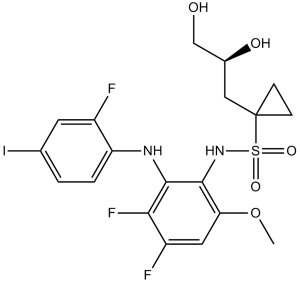Refametinib (RDEA119, BAY86-9766)
This product is for research use only, not for human use. We do not sell to patients.

For small sizes, please check our retail website as below: www.invivochem.com
| Size | Price | Stock |
|---|---|---|
| 250mg | $899 | Check With Us |
| 500mg | $1330 | Check With Us |
| 1g | $1995 | Check With Us |
Cat #: V0461 CAS #: 923032-37-5 Purity ≥ 98%
Description: Refametinib (formerly RDEA-119, BAY 86-9766) is an orally bioavailable, highly selective and non-ATP-competitive (allosteric) inhibitor of MEK1/2 with potential antitumor activity.
Top Publications Citing Invivochem Products
Publications Citing InvivoChem Products
Product Promise

- Physicochemical and Storage Information
- Protocol
- Related Biological Data
- Stock Solution Preparation
- Quality Control Documentation
| Molecular Weight (MW) | 572.34 |
|---|---|
| Molecular Formula | C19H20F3IN2O5S |
| CAS No. | 923032-37-5 |
| Storage | -20℃ for 3 years in powder formrrr |
| -80℃ for 2 years in solvent | |
| Solubility In Vitro | DMSO: 100 mg/mL (174.7 mM)rrr |
| Water: <1 mg/mLrrr | |
| Ethanol: 100 mg/mL (174.7 mM) | |
| SMILES Code | O=S(C1(C[C@H](O)CO)CC1)(NC2=C(OC)C=C(F)C(F)=C2NC3=CC=C(I)C=C3F)=O |
| Synonyms | PD318088; PD 318088; PD-318088 |
| Protocol | In Vitro | Refametinib (BAY 869766; RDEA119) selectively binds directly to an allosteric pocket in the MEK1/2 enzymes. Refametinib potently inhibits MEK activity in enzyme inhibition assays in a non-ATP-competitive manner (MEK1 IC50=19 nM, MEK2 IC50=47 nM) determined through incorporation of radioactive phosphate from ATP into ERK as substrate. Refametinib potently inhibits MEK activity as measured by phosphorylation of ERK1/2 across several human cancer cell lines of different tissue origins and BRAF mutational status with EC50 values ranging from 2.5 to 15.8 nM. Refametinib inhibits anchorage-dependent growth of human cancer cell lines harboring the gain-of-function V600E BRAF mutant with GI50 values ranging from 67 to 89 nM. In contrast, Refametinib has significantly less growth-inhibitory potency against cell lines with wild-type BRAF (A431 cells) or MDA-MB-231 cells harboring a BRAF mutation G464V that shows minimal (<2-fold increase) enhancement of inherent kinase activity. Under anchorage-independent conditions, GI50 values for all cell lines tested are similar (40-84 nM). MDA-MB-231 and A431 cells are significantly more sensitive to Refametinib under anchorage-independent conditions. |
|---|---|---|
| In Vivo | Refametinib (BAY 869766; RDEA119) is an orally available, potent, non-ATP-competitive, highly selective inhibitor of MEK1/2, which is active in human tumor xenograft models and is well tolerated within the therapeutic exposure range in animals.The human melanoma A375 tumor xenograft is found to be sensitive to Refametinib treatment with 54% and 68% tumor growth inhibition (TGI) seen with 25 and 50 mg/kg/d administered orally on a once daily ×14 schedule. Significant tumor growth delay (TGD) and regressions are also observed in A375 tumors on this once-daily schedule. For example, five to eight complete or partial responses (CR/PR) and up to six tumor-free survivors (TFS) are observed. Administering Refametinib every other day at 100 mg/kg is less effective than daily dosing with either 25 or 50 mg/kg. When Refametinib is dosed on a twice-daily schedule, it is more effective than once-daily schedules. |
These protocols are for reference only. InvivoChem does not
independently validate these methods.
| Solvent volume to be added | Mass (the weight of a compound) | |||
|---|---|---|---|---|
| Mother liquor concentration | 1mg | 5mg | 10mg | 20mg |
| 1mM | 1.7472 mL | 8.7361 mL | 17.4721 mL | 34.9443 mL |
| 5mM | 0.3494 mL | 1.7472 mL | 3.4944 mL | 6.9889 mL |
| 10mM | 0.1747 mL | 0.8736 mL | 1.7472 mL | 3.4944 mL |
| 20mM | 0.0874 mL | 0.4368 mL | 0.8736 mL | 1.7472 mL |
The molarity calculator equation
Mass(g) = Concentration(mol/L) × Volume(L) × Molecular Weight(g/mol)
Mass
=
Concentration
×
Volume
×
Molecular Weight*
The dilution calculator equation
Concentration(start)
×
Volume(start)
=
Concentration(final)
×
Volume(final)
This equation is commonly abbreviated as: C1 V1 = C2 V2
Concentration(start)
C1
×
Volume(start)
V1
=
Concentration(final)
C2
×
Volume(final)
V2
Step One: Enter information below
Dosage mg/kg
Average weight of animals g
Dosing volume per animal µL
Number of animals
Step Two: Enter the in vivo formulation
%DMSO
+
%
+
%Tween 80
+
%ddH2O
Calculation Results:
Working concentration:
mg/ml;
Method for preparing DMSO master liquid:
mg
drug pre-dissolved in
µL
DMSO(Master liquid concentration
mg/mL)
,Please contact us first if the concentration exceeds the DMSO solubility of the batch of drug.
Method for preparing in vivo formulation:
Take
µL
DMSO master liquid, next add
µL
PEG300, mix and clarify, next add
µL
Tween 80,mix and clarify, next add
µL
ddH2O,mix and clarify.
Note:
- (1) Please be sure that the solution is clear before the addition of next solvent. Dissolution methods like vortex, ultrasound or warming and heat may be used to aid dissolving.
- (2) Be sure to add the solvent(s) in order.




































